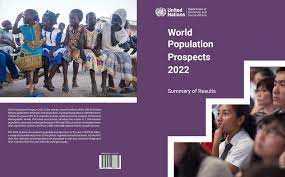An United Nations report brought out on 11th July shows that population is growing at a slower pace , the world over, whereas in India it is other way round. As per report, population of India will reach a figure of whopping 1.428 billions as on 1st July,2023. It will be marginally higher than 1.426 billion figure of China at that time. At present ,India’s population is only 8.7 millions less than that of China. Both are labour intensive economies from economic growth point of view as compared to countries of Western Europe and U.S.A.
2) India ,unfortunately may hit the top position in terms of population ranking with 1403 millions by 2025 and 1,697 billions by 2064. One , therefore, gets an impression that national population policy of China has proved effective if their statistics is to be believed but only after proper verification. From earlier One Child norm, they are advising couples to have atleast two children.As such China’s population has begun showing a decreasing trend from 2021 onwards. It is felt that more strict Covid instructions issued for the last four months also may have a bearing.
3) The U.N. report , released every two years, contains population figures of past in addition to projection of population upto 2100.
Rise in global population is reported to be in line with the increase in Life Expectancy (L.E.)at birth till 2050. This figure of 71.7 years in 2022 may rise by almost five years to 77.2 years by 2050.
When it comes to India, L.E. of 68 years for males and 71 for females in 2010 will rise to 72 and 76 years respectively by 2025.
In the same way, Indian Sex Ratio of 932 in 2000 may rise to
950 per thousand males by 2025.The Demographic Bonus may also result in an increase in Working Age population (15 to 64 years) from 603.98 millions in 2000 to 942.54 millions by 2025.
Demographic Dividend (D.D.)

4) Scenario as above is normally expected to ensure better opportunities for economic growth of the country or favourable demographic dividend as eloquently highlighted by the Prime Minister from time to time in his speeches.
Since it will also lead to boost the rate of urbanisation and industrialization ,more investment in physical and human infrastructure would be possible. However, D.D. can also turn into a liability if India does not produce enough job opportunities and required skilled workforce.
5) According to Confederation of Indian industries( C.I.I,), India’s working population is not sufficient for it to sustain the needed economic growth.In view thereof, enhanced level of education and skill development aligned to needs of industry is very much required. India thus can become a global production hub ,at the same time, more consumption of goods and services will take place.
C.I.I. further cautions that in view of the fact that majority of the children did not have the benefit of face to face education for two years due to Covid pandemic, it may add to Learning Gaps .As such, only 3% of labour force of India is formally skilled as compared to 80% in Japan, 68% in U.K., 52 % in USA and 24 % in China. So Multi Skill Training Institutes in MSME clusters are very much badly needed in our country. With more close collaboration and partnership between the Government and the industry our number of formally skilled labourers is bound to rise.
Most Populous Countries
6) According to the U.N. report in question, five most populous countries as in 2022 were: China (1426 millions), India(1412 millions),USA(337 millions),Indonesia( 275 millions) and Pakistan(234 millions). These were closely followed by Nigeria,Brazil, Bangladesh, Russia and Mexico.By 2050, India is expected to be topper with 1668 millions,followed by China( 1317 million) and USA(375 millions).
While China and USA would have controlled their population by 2050, Nigeria ,on the other hand would increase it to 375 millions as against 216 millions in 2022 and Pakistan too will have a rise to 366 millions as against 234 millions in 2022.
Need For Fresh National Population Policy (N.P.P.) In India
7) For a long time we are not having a National Population Policy. The last such policy was given shape by the then Planning Commission in 2000. Whenever such demand is raised, including in Parliament, Central Government sources say that so far Fertility Rate is satisfactory in India.If that is the case, how the latest U.N. Report speaks otherwise ?
8) Incidently , U.P. is the only State which is thinking positively to have such a policy. But as per some observers, the proposed policy may target a particular community as their fertility rate is much higher.
The U.P. Population(Control , Stabilisation and Welfare) Bill,2021, introduced on 7th July 2021,aims to control the population of the state. Its goal is to reduce state Fertility Rate(F.R.) to 2.1 per thousand population by 2026 and 1.9 by 2030. Current F.R.of the state is 2.7 per thousand population. It aims to help in improving the overall welfare of the people.
The Bill is said to divide the population into two groups:
a) First encouraging individuals along with their spouses to go for voluntary sterilization after having two children,
b) Secondly, debarring individuals with more than two children from applying for Government jobs, promotions & subsidies.
9)Earlier two child policy initiatives of Assam, M.P., Haryana, Rajasthan and Odisha have led to sex- selective and unsafe abortions. Abandoning of girl child or even husband deserting his wife alongwith girl child may be possible, or same may be happening already.
Apart from further improving the financial condition of a family, improving literacy can certainly help. Delaying marriages is bound to be one of the best measures.At the same time,male participation in the sterilization processes can also help in improving their health.
10) N.P.P.,2000 had identified 13 Social and Demographic objectives ,the target year for which was 2010. However, no follow up report has come in public domain.

(11) IMPACT INDICATORS
These were:
* Total Fertility Rate was to be brought to Replacement Level,
* IMR was to be below 30 per 1000 Live Births,
* MMR was to be reduced to below 100, per one lakh births,
* Girls were not to be married before 18 years,
* Given targets for contraceptives, health infrastructure and personnel were to be achieved,
* Universal Immunisation was to become a success,
* 80 % Institutional deliveries were to be achieved,
* State governments were to ensure cent percent Registration of Births, Deaths, Marriage and Pregnancy.
(12) In addition, the NPP also stressed on PROGRAMME INDICATORS, such as:
^^ Free education upto 14 years of age,
^^ Drop Out rates were to be reduced,
^^ Universal information and Counseling,
^^ Wide choice for Contraceptives was to be offered,
^^ Incidence of AIDS was to be contained seriously,
^^ More control over Communicable Diseases was to be exercised,
^^ Convergence with social Sector programmes so that Family Planning could become a public Centre activity. Further F.P. must be adaptive to changing needs,
Scenario For Period 2001 to 2026
13) It was noted that eight States of country will have only 15 % population as Replacement Fertility Rate would be already achieved. These would be ,Kerala, Tamil Nadu, A.P., Karnataka, Punjab, H.P., Goa and SIKKIM.
However , ten states of Arunachal, Bihar, Jharkhand, M.P.,U.P., Manipur, Mizoram, Meghalaya, Nagaland and Rajasthan would still contribute to 48 % of India’s population as these states will have relatively higher fertility rates.
14) TO SUM UP,
In view of above facts and statistics, one can sense and expect an alarming scenario on population front. It is still the root cause of most of our social ills leading not only to rise in crime but emergence of crimes linked to day to day technological advancements.
In good faith, therefore, following measures Need To Be adopted in India if objective of Population Stabilisation was to be achieved :
Immediate Reduction of IMR & MMR,
Vasectomy To Be Given More Impetus,
More rise in Female Literacy, Awareness & Further Empowerment of Women,
Improvement in the domain of Infant Nutrition( Anganwari Workers and ASHA ‘s have to be more alert)
Institutional Deliveries will have to be insisted upon to ensure better health of women.
Raising of Age of Marriage to 20 & 23 years, respectively,
Increase of Gap Between Two Births,
Together with Reduction in Fertility, Efficient Health Care Management Will Be Needed,
Improve Administrative Capacity & Organisational Efficiency, and
Controlled Urbanisation and Migration Strategies to be stressed upon. N.C.R. may have to be specially taken care of.

About the Author : Dr. Aaloc Srivastav, Ex CS , Sikkim is a Senior Retd Bureaucrat and passionate about writing on his favourite subjects . The views shared by the author are his personal.





